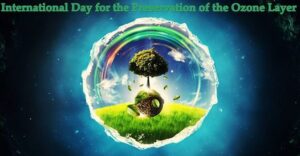
Life on Earth relies heavily on sunlight.
Without it, weather, ocean currents, seasons and climate will be severely affected, and photosynthesis would not occur, which means no crops or organic matter, or no release of oxygen.
Yet, the intense energy radiated from the sun would be detrimental for life on Earth to thrive were it not for the protective Ozone Layer.
This is crucial for shielding us, like a blanket, from harmful solar rays and also for trapping heat in to the atmosphere. Most importantly, it absorbs the portion of UV light called UVB, which has been linked to many harmful effects, including skin cancers, cataracts, and harm to some crops, plants, and marine life.
In the 1970s, compelling scientific evidence emerged, showing us that human activities were causing severe depletion of the ozone shield, far exceeding natural processes.
However, over the past 3 decades, humans have successfully phased out many of the chemicals that harm the ozone layer!
International Day for The Preservation of The Ozone Layer commemorates the signing of the Montreal Protocol on Substances that Deplete the Ozone Layer in 1987. This is an important day to commemorate as this day ended a huge threat to humanity as a whole: the depletion of the ozone layer.
When the world found out that ozone-depleting gases used in aerosols and cooling (fridges/Aircons) were creating a hole in the sky, they came together. They showed that effective global cooperation worked, and they phased out these gases. Now the ozone layer is recovering, allowing it to shield humanity from the sun’s ultraviolet radiation once again.
The day serves as a celebration of how collective decisions and action, guided by science, are the primary means to solving major global crises. It also reminds us that not only is ozone crucial for life on Earth, but that we must continue to protect the ozone layer for future generations.
How can you ensure you are helping the ozone layer?
- Check your fire extinguishers
- If “halon” or “halogenated hydrocarbon” is the main ingredient, find a hazardous waste centre at which to recycle it or call your local fire department for instructions on how to dispose of it.
- Don’t buy aerosol products with chlorofluorocarbons (CFC)
- Dispose of pre-1995 refrigerators, freezers, and air conditioning units properly
- Buy lumber, wood products and plywood that were not treated with methyl bromide
- Invest in renewable enrgy such as Solar Panels to limit the bruning of fossil fuels
- Drive less
- Nitrous oxide is now the largest ozone-depleting substance released by human activities and it is produced in the internal combustion that powers most cars.
- Eat less meat
- Nitrous oxide is also produced when manure decomposes, making poultry, beef, and dairy farms large producers of the gas
- Buy local
- The further your food or other goods have to travel to reach you, the more nitrous oxide will be produced by the engines that bring them to you












